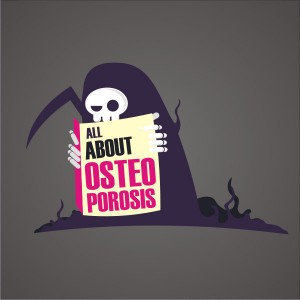I began taking estrogen at 44 after having a total hysterectomy. No ovaries. No estrogen. After popping the little pills for over 15 years, I worried about whether they were increasing my risk of getting breast cancer, so I quit taking them two years ago. (It’s never easy weighing the benefits and risks of everything we do to and with our bodies.)
While I was still on estrogen, I passed the bone density test with flying colors. My score dropped noticeably, post-estrogen, and the report indicated that I had osteopenia. Oh great, I thought. Should I go back on estrogen, which is wonderful for my bones, and risk breast cancer? Or should I stop estrogen and risk osteoporosis?
I called an orthopedic surgeon I knew, who recommended that I start taking Actonel to build up my bones. I also called my long-time gynecologist, who told me it was fine to continue the low doses of estrogen (but warned me that if I had been off it for more than a year, it could cause a heart attack if I suddenly started again.)
OMG, I thought. Whose advice should I follow?
I had a million Geri Brin questions. Is Actonel the same as Boniva? Are these drugs safe? Do I need to drink milk like I did when I was 10? Should I start taking calcium supplements and how much? How bad is my osteopenia and will I absolutely develop osteoporosis? Will exercise really help?
I’d better learn as much as I can about bone health before deciding. When my grandmother broke her hip twenty-five years ago, at 80, it was expected. Women got old, their bones became brittle and that was that. We’re luckier than our grandmother’s generation because we know more about bones and how to keep them healthy, but what’s the best plan for my bones?
We decided to create an FOF Bone Health Challenge so I could get the answers I needed, and so, too, could hundreds of thousands of other FOF women. When I Googled osteoporosis and started wading through the murky waters of most health websites, I thought I’d drown in an ocean of sketchy, unreliable and contradictory information. I’m a reporter so I can tell in a moment when articles are poorly researched.
Thanks to a partnership with the experts at the Cleveland Clinic and the National Osteoporosis Foundation, FOF has launched the first National Bone Health Challenge. The videos and case studies are easy to follow, plus you can ask the docs questions and have a chance to win an incredible package of goodies worth $3,000.



13 Responses to “Osteoporosis can be pretty scary stuff”
sharyn reiner says:
If you live in NY, Dr. Felicia Cosman, Clinical Director of the National Osteoporosis Foundation is available to see patients at Helen Hayes Hospital in West Haverstraw, N.Y. She is involved in the latest studies and has moved me from osteoporosis to osteopenia.
Barbara Sargent says:
RE: Sharyn Reiner’s progression from porosis to penia.
HOW? How did she do it? I am working up the nerve to start Forteo a daily injectable. As an R.N. this should not be a big deal. Unfortunately, I am one of the “rare” ladies who experienced necrosis of the jaw on oral osteoporosis medications. I also got polio from receiving the vaccine when I was around 4 or 5 years old so as you can see I embrace the unusual!
Seriously, if there is ANYTHING else you can recommend I would be so grateful. I have had three fractures this year and am afraid of losing my independence or my life with my poor, poor bones.
Barbara
Toby Wollin says:
“According to national statistics following a hip fracture:
– 20 percent of women die within one year
– 20 percent become permanently disabled
– More women will die of hip fractures nationally than will die of breast cancer.
– In the U.S. hip fractures cost 18 billion dollars a year in hospital care expenditures. ”
http://www.medicalnewstoday.com/articles/84466.php
And it is not just hip fractures:
“..women with upper arm fractures are five times more likely than the general population to experience a broken hip in the 12 months following the arm fracture, according to a study published in the March 2009 issue of The Journal of Bone and Joint Surgery (JBJS). Understanding that risk can be a key to preventing those fractures, the study notes.”
http://www.medicalnewstoday.com/articles/140811.php
Toby Wollin says:
All I can say is this: Don’t wait for something to happen to you, figuring ‘oh, I’ll take of it when something happens.” Falling and breaking a hip or a shoulder is extremely dangerous for women and frankly, once it’s happened, the chances of falling again and breaking something else are extremely high. So, we need to do everything we can to prevent the very first fall.